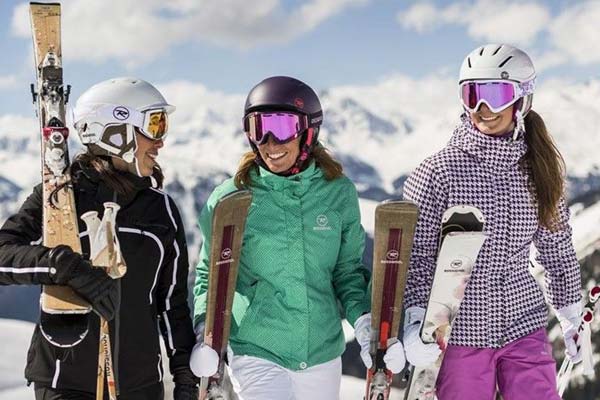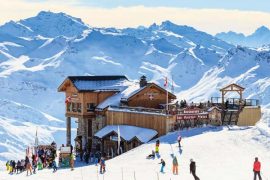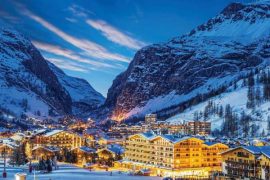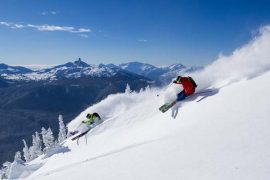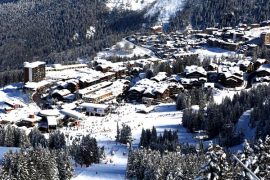Mother Nature is never predictable, especially when it comes to the combination of winter, mountains, and skiing or snowboarding. If you overdress, you feel smothered. If you underdress, you get cold. So how does one plan their wardrobe accordingly?
It is always best to wear clothing specifically made for the sport. Ski apparel is made for comfort, warmth, and ease of movement. You need to make sure that you have all the elements of the proper attire to be truly ready to ski.
The main key to dressing appropriately for skiing is layering. You will always need to wear long pants, long sleeves, and gloves no matter what part of the season it is. Mother Nature can be just as volatile during the spring as she is during the middle of the season.
Best dressed for the slopes does not mean who has the coolest outfit. It means how you can be dressed for a comfortable and successful day of skiing. While it is possible to find ski clothes that are stylish, it is more important for them to be functional.
The National Ski Patrol recommends that to be properly prepared for any conditions, that the following clothing layers and equipment are used for skiing and snowboarding.
One thing that you need to keep in mind is that ski clothing is not cheap. When you commit to ski attire, you need to be prepared to make an investment. If you are still a beginner, most rental shops offer rental clothing. You will need to make sure that skiing is for you before you make this investment.
The Bottom Layer Is Just As Important As The Top Layer
Long underwear has always been an important first layer. Cotton has always been the standard fabric. New technology gives you a number of other choices. The base layer should function in such a way that it keeps moisture away from your skin.
While cotton is breathable, it also will hold moisture more than other fabrics. While it is still preferred by some people, there are new options that will be comfortable, warm, and will serve to keep moisture away from your skin.
The moisture factor is an important one. When you have a hard day of skiing, the body sweats. If your long underwear becomes soaked with sweat, the traditional cotton will tend to stay damp against your skin.
Newer long underwear is made differently. Technology makes it possible for micro-fleece material to wick the moisture away from your skin while at the same time, keeping you warm and dry.
A polyester and spandex mix allows for both comfort and a full range of motion. They come in three types: fleece-lined lightweight and mid-weight as well as a waffle-knit that does incorporate cotton into the fabric. There are styles for both men and women.
Having both a long underwear shirt and leggings is important. They will only be completely effective if you tuck your shirt into your leggings. Failure to do so will land you with a lot of snow against bare skin after one fall in the snow.
Even if it is a warm spring day, it is never a good idea to not at least wear a light layer as a bottom layer. Many a seasoned skier will agree that ‘no layer’ should never be your bottom ‘layer’.
The Middle Layer Should Never Be Denim
While you will see some people out there skiing in blue jeans, one good wipeout will tell you why this is a very bad idea. Wet denim is not only cold but also can become stiff as it drys or freezes. This is only one of the reasons why it is not recommended.
It is also recommended that sweatpants not be your second layer. Cotton, while comfortable against the skin, will soak through making you cold and allowing your temperature to fluctuate. When skiing, it is important to keep your temperature even.
The function of the middle layer is to keep you warm. Trapping your body heat will keep you warm. This is not just for comfort. If you get cold, your muscles might not be as flexible as you need them to be for a good day of skiing.
Ski pants are not a vanity purchase. If you are going to ski, they are an absolute necessity. Whether you prefer regular ski pants, bib overalls, or a one-piece snowsuit style is a personal preference. Ski pants are made the way they are for a reason.
When you ski, you move in many different ways. From keeping your knees bent over your boots to leaning into your turns or twisting as you reach back to grab the chair lift, freedom of movement is key. Ski pants are designed with this in mind.
There are differing schools of thought on ski pants. Those styles that would, at first glance seem to be the warmest have their drawbacks. Likewise, those that look form-fitting and like they are made of thinner material can actually be your best choice.
If your pants are slick on the outside, the fabric can make it so that when you fall, you will slip and slide your way down the mountain. This can make your fall even worse and subject you to a greater chance of serious injury.
Stretch ski pants might not look to be as well insulated as others, but they have always been preferred by the truly dedicated skier. These skiers know what kinds of layers they will need, and they prefer the freedom of movement offered by this type of ski pants.
Ultimately, your choice of ski pants should consist of various factors. What kind of climate are you planning to ski in? How good of a skier are you? There are several different types of ski pants available for you to choose from.
When looking for the right size, remember that you will be wearing layers. If you are looking at ski pants with suspenders, you will need to adjust the size of your jacket. Each piece of your ski wardrobe ultimately affects the other pieces as well.
No matter what style you choose, you will want to make sure that your ski pants are long enough to cover your boots. This is traditionally considered to be a good four to five inches longer than your normal inseam length.
Moving to what you wear on top while skiing is relatively simple. Your middle layer should be a turtleneck. Depending on the thickness of your long underwear, expected conditions on the mountain, and the weather will help you choose appropriately.
Just like long underwear, turtlenecks come in a range of fabrics. It is best to look for a turtleneck that is not too thick and not too thin. While you can always lose a layer here and there should you become too warm, it is important that you at least stay warm enough to stay healthy.
A good lightweight turtleneck shirt is your best bet for this middle layer. There are a number of different fabric selections when it comes to this layer. A cotton/rayon blend is relatively standard, although cotton/polyester blends and pure wool is also easily available. This is all a matter of personal preference.
Another aspect of this middle layer would be the more standard ski sweater. These can be found in a range of colors, weights, and fabrics. Traditionally, a warm wool sweater is preferred for this part of the middle layer.
For men, there are standard options in a traditional zip neck or a more retro style with padded elbows. Both of these styles are traditionally a wool or wool-blend sweater.
Women probably have more options in ski sweaters. While a wool or wool blend is preferable, there are a number of rayon blend options available as well. The women’s traditional zip neck sweater and the women’s crew neck sweater are standard fares.
The key to layering though is the fact that layers can be removed as necessary depending on the conditions once you actually get out on the mountain. The sweater layer should be one of the ones that you can easily remove if necessary.
The Top Layer Is The Most Important
Finally, we have the top layer. The top layer is there to shield you from the wind and the snow. The weight of this layer will depend on the conditions you will be skiing in.
For those on a budget, your best bet would most likely come in the form of a parka that can be customized via zipping in or out at least one layer. When in full form it is an effective parka, layers can be removed until it is nothing more than a thin shell
These ski jackets are known as a 3-in-1 jacket. They have several options in both men’s 3-in-1 jacket and the women’s 3-in-1 jacket.
For the more traditional down parka, there are options for men’s traditional down parka as well as a women’s traditional down parka.
Whichever type you prefer, you will need to make sure that for skiing, the jacket should not be longer than hip length. This is for ease of movement and safety concerns as you don’t want to have your jacket make any falls you may take be even worse.
Socks Are Almost As Important As The Boots
When it comes to skiing, socks are a very important aspect of your attire. Ski boots have a very specific fit. Whether you prefer to wear thin socks or thick socks is a matter of preference. This preference should be considered when you are getting your boots fitted.
Anyone who has been skiing for some time knows that if your boots are too tight, you are in for a very uncomfortable day on the mountain. Many blame the thickness of their socks on this issue.
Thinner ski socks are more common these days. A wool blend is usually best, and come in medium weight and lightweight depending on your preference and the fit of your boots.
If you are heading into conditions that are known to be extremely cold, you might want to consider layering your socks as well. There are several different kinds, but for the best comfort, a cotton blend liner will not only keep you warmer but will also keep you more comfortable as normal ski socks are known to be rather itchy.
Don’t Forget Your Gloves
When it comes to your hands, you need a waterproof glove for skiing. These should always be fingered gloves and never mittens. They should also never be knit. The waterproof aspect is extremely important.
Waterproof gloves are pretty standard in design. These gloves will give you not only the warmth you need but the extra protection from those annoying falls that are almost inevitable. These days, they are not as bulky as in the past. These Thinsulate gloves will keep your hands warm and dry.
Additional Items To Consider
If you still have concerns that you might not be warm enough, there are some additional items you might want to bring along. Helmets are an important part of staying safe while you are skiing. It is always a good idea to wear a close-fitting beanie beneath your helmet.
In certain conditions, a balaclava or full-face ski mask is a necessity. These will keep your face protected against sun, snow, and wind.
Although a balaclava can be useful in very cold weather, it is important that you always wear sunblock of at least spf30. Sun and windburn can be a guaranteed product of skiing without it. A good moisturizer is also recommended for once you come off the slopes.
You will want to bring dry hats and gloves for the end of your day to keep you warm once the ski gear comes off. There are no specific recommendations for after ski attire. Whatever you most prefer.
